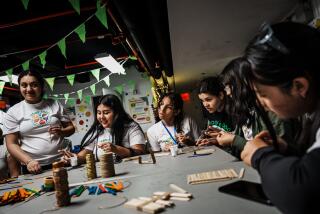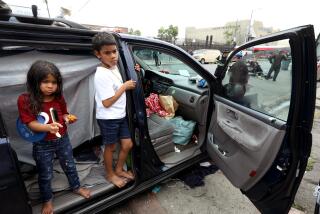Haves, Have-Nots Help Homeless : Volunteerism: Teen-agers, church members make trips into Manhattan to feed and clothe those less fortunate. The effort to lend a human touch benefits both givers and receivers.
KATONAH, N.Y. — Deep in the heart of affluent Westchester County, in a picturesque white church surrounded by rolling hills and graceful homes, a small group prepares for an alien world.
Sprawled on the church floor, surrounded by bags of food and clothing, some of the adults and teen-agers look scared as they hear what awaits them.
“If you’re nervous at all,” 38-year-old Bart Tyler said, “try not to worry. The first time I went out I was a little frightened, but once we got there, everything fell into place.”
Earnest and clean-cut, Tyler could be fresh off the bridge of some sci-fi spaceship, briefing lieutenants for a foray to an uncharted galaxy.
In fact, he’s the chief executive officer of a restaurant equipment repair company. And tonight he will introduce some high school kids, their principal and an investment banker to the rough terrain of Manhattan’s homeless.
The vehicle that will bring together these haves and have-nots is Midnight Run--born eight years ago when the Rev. Joe Gilmore, pastor of a church in Dobbs Ferry, began driving the 20 miles down to Manhattan with a few people several times a month to help feed and clothe the homeless.
The idea, Gilmore stresses, is to benefit both the givers and the receivers. He does not pretend the program does more than gently assuage some of the suffering on the streets.
“It’s a process of humanization,” says Gilmore, “that somehow deepens in the midnight darkness. By dawn, it’s as if we have subverted some the violence and harshness experienced by the homeless poor during the day.”
The Midnight Run now involves more than 50 different groups of many denominations. It has just one salaried employee, a formerly homeless man named Dale Williams, who operates out of a Dobbs Ferry office.
Groups go on runs several times a week; they return with the knowledge that there are names, faces and personalities attached to the homeless.
“I thought I’d be meeting really messed up people who were out of the mainstream,” 16-year-old Ethan Maass says. “But I found a lot who were pretty normal.”
As the volunteers hurtle down the Saw Mill Parkway in a silver-colored van with license plates reading “MIDNITRN,” the comforting, wide-open spaces of Westchester slowly recede. The Manhattan skyline comes into view.
The van carries 250 brown bags, each containing two sandwiches, fruit, a hard-boiled egg and two cookies; four tureens of soup and coffee; blankets and piles of clothing. Perched among them are students from John Jay High School, their principal, Laura Frenck, and Kirk McAfee, 32, an investment banker.
“I want you to think of all this stuff as your calling card,” Tyler says, referring to the van’s supplies. “This is about calling on people. You’re the most important thing we’re bringing in this van. The idea that you’re coming down to see them--not to avert your eyes--is very significant to them.”
It’s the first trip for Frenck, McAfee and about seven of the students.
“These kids don’t know what it’s like to be homeless and on the streets.” Frenck says. “I’m not sure I do either.”
The Midnight Run leaders have a loose network of stops in the city. Some are areas where dozens of homeless congregate. Other times they may stop for a few people camped out under a bank awning. Sometimes the homeless, almost all of whom know the Midnight Run, will run up to the van and stop it themselves.
Tyler has allowed a reporter and photographer to accompany the group on this night. They agree not to identify the location of the stops, for fear that the homeless might be evicted if their encampments are made public.
It is raining and about 40 degrees at 11 p.m. when the van pulls up on a side street on Manhattan’s West Side. The volunteers descend down a dark stone stairway to a scene that was part “Bleak House,” part “Blade Runner.”
Dozens of silent, shadowy figures roam an open-air city of cardboard boxes and mattresses. But as soon as they see the volunteers and bags of food, the figures assume very human forms.
“If they didn’t come, I’d be disappointed,” says John Walker, 25, easing out of his cardboard box after Paul Llanos, 16, pokes his head in to say he was from the Midnight Run. “I also might be hungry.”
Walker, a groundskeeper who was recently laid off, has lived here with his girlfriend for several months. He says he’s looking for work.
Michael Hamilton, 35, runs up to the van and finds a New York Mets jacket in the pile of donated clothing. He says he’s living here while he waits for public housing. He says he does messenger work during the day and hopes his homelessness is temporary.
“These people are really terrific,” he says, as volunteer Michelle Leonard, 15, pours a cup of chicken soup. “They help with job referrals and their attitude is so good, it leaks into you. They give you motivation.”
Leonard, a veteran of the Midnight Run, says her encounters with people like Hamilton give her a “whole different perspective.”
“These were once people who were my age and went on to have jobs. If this could happen to them, it could happen to me--and I wouldn’t want people to be afraid to come talk to me.”
Toward the end of this run--they typically start sometime after 10 p.m., and end sometime before 4 a.m.--Tyler spots two shapes huddled beneath one blanket under a bank overhang near the East River. He stops, and McAfee jumps out and walks over to them.
“Hi, I’m from the Midnight Run,” he says.
Slowly, two older women raise their heads from underneath the blankets. They appear intelligent, lucid and dignified; do they want some soup or hot coffee? Yes, they say.
McAfee brings them four steaming cups, and places another blanket over them. They thank him. Nobody asks them how they came to this sorry spot.
Back in the van, several volunteers watch as the women drink the soup and coffee and put their heads back on the worn knapsacks they use as pillows.
And then, the van drives away.
More to Read
Sign up for Essential California
The most important California stories and recommendations in your inbox every morning.
You may occasionally receive promotional content from the Los Angeles Times.






